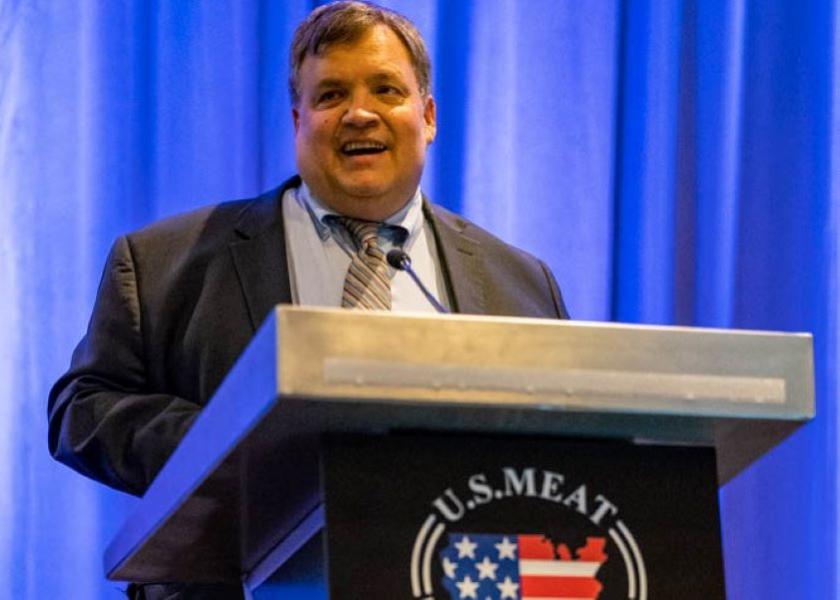USMEF Experts Weigh in on Opportunities for U.S. Market Share Gains

Producers, exporters, packers, processors and traders from across the nation are gathering in Minneapolis this week for the U.S. Meat Export Federation (USMEF) Spring Conference.
Minnesota Agriculture Commissioner Thom Petersen welcomed the attendees, praising their collaborative efforts to advance U.S. agriculture by building global demand, USMEF said in a release.
“I really wasn’t a ‘feed-the-world’ type of person when I started as commissioner,” Petersen explained. “But as you get out on trade missions and see the world – big cities like Bogota and Lima, and even London and Manila – you realize there’s just a lot of people that need to be fed. This association and others do really good work to bring that forward.”
USMEF President and CEO Dan Halstrom shared an overview of the competitive landscape, identifying and detailing opportunities for U.S. market share gains. He discussed the sharp decline in European pork production, which fell nearly 6% last year. With this trend continuing in 2023, the U.S. pork industry is in an outstanding position to capitalize on a favorable price and supply situation, especially in the Asia Pacific region, Halstrom said.
“One of the largest suppliers of pork in the world is down and is likely to remain hamstrung,” Halstrom said. “And when you look at the whole global protein pie, this has implications for beef as well. I’m a marketing guy, and I see this as a big opportunity for the U.S. industry.”
Exports of U.S. beef began the year considerably lower than a year ago, due in part to tight supplies, but began regaining momentum in March. Halstrom said consumer demand in markets such as Mexico and the Caribbean has strengthened with the rapid recovery in travel, tourism and foodservice activity, but the COVID pandemic’s impact has lingered longer in many Asian markets.
Maximizing carcass value is a global objective for USMEF, with the pork loin and beef round as featured primals in these market development efforts. USMEF’s top culinary experts, which included Mexico-based Corporate Chef Germán Navarrete, ASEAN Director Sabrina Yin, ASEAN Chef Jonathan Neo, Chilean Chef Sebastian Gre and Caribbean Representative Liz Wunderlich discussed how USMEF partners with importers and distributors to educate customers in the foodservice sector on the versatility and adaptability of underutilized cuts for use as center-of-the-plate items in both traditional cuisine and new menu concepts.
USMEF’s commitment to promoting underutilized cuts is especially critical during times of tight supplies, Yin added.
The session closed with a joint presentation by Joel Haggard, USMEF’s senior VP for the Asia Pacific, and his successor Jihae Yang. After overseeing very successful efforts to expand demand for U.S. beef and pork in South Korea, Yang has taken on the expanded role of Asia Pacific vice president as Haggard moves toward retirement, USMEF said in a release.
Haggard discussed the U.S. industry’s decades of investment in Asian markets, laying the groundwork for future demand even when market access was severely limited by high tariffs and other obstacles.
"As these barriers eased over time, U.S. pork and beef exports achieved tremendous growth in major destinations such as Japan, South Korea and China, but always with an eye on potential expansion in emerging markets," USMEF explained in a release.
Yang detailed the prospects for continued growth in Asia with a particular focus on the ASEAN. The region’s enormous consumer base has a growing need for high-quality protein at a time when domestic livestock producers are challenged by high input costs and significant animal health issues, she said.
The conference continues Thursday with a general session examining the current state of U.S.-Mexico trade relations. This will be followed by meetings of USMEF’s standing committees, which focus on issues specific to the organization’s pork, beef, exporter and feedgrains and oilseeds sectors. At Friday’s closing session, former House Agriculture Committee Chairman Collin Peterson will provide an update on development of the next Farm Bill.







